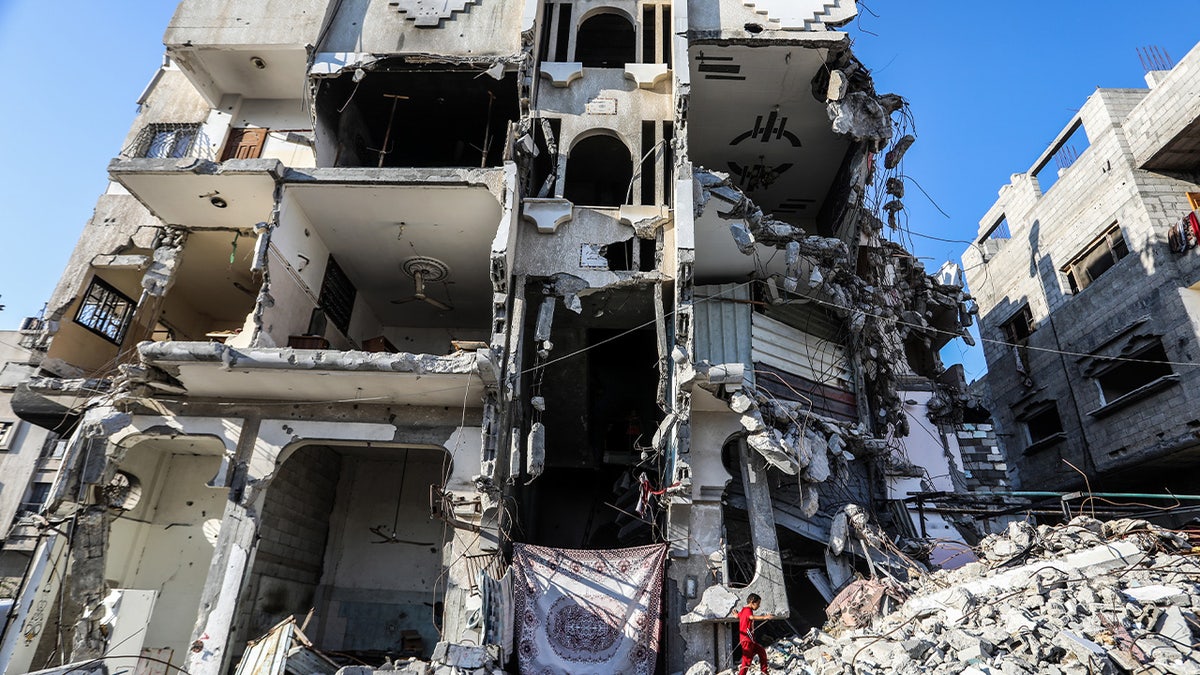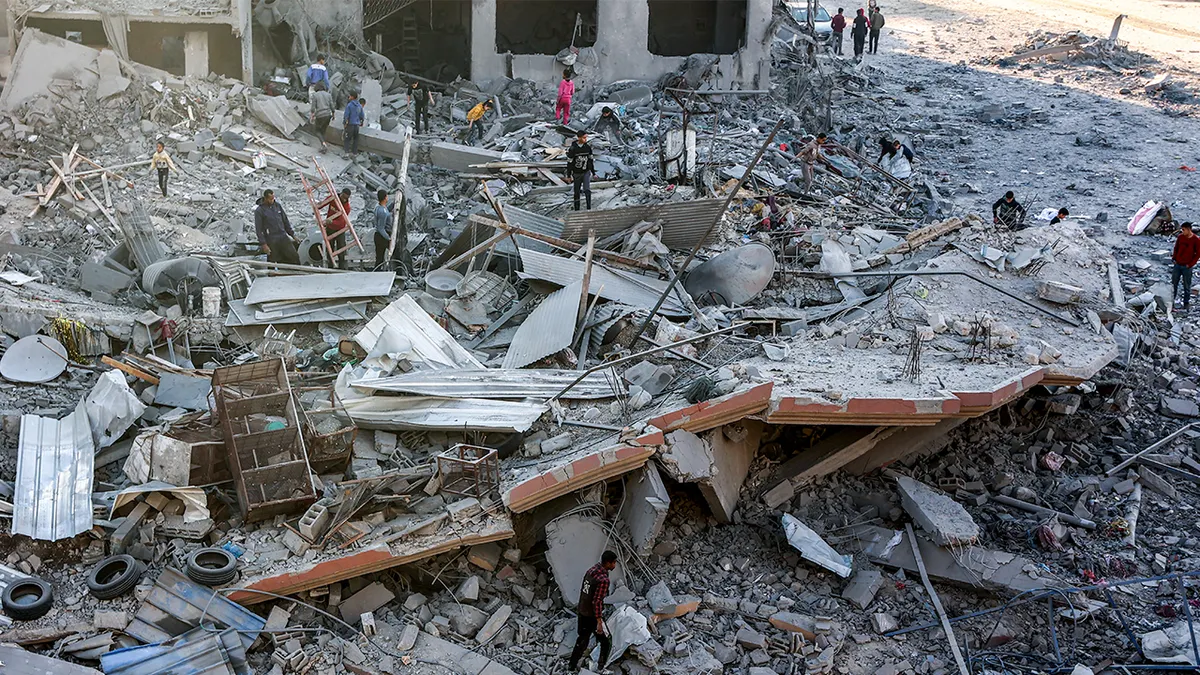In an audacious transfer that shocked the world, President Donald Trump unveiled a proposal to relocate 1.8 million Palestinians from Gaza, in search of to rebuild their lives in new locations. Addressing the media alongside Israeli Prime Minister Benjamin Netanyahu on the White Home, Trump outlined his formidable imaginative and prescient for the Gaza Strip.
“I strongly consider that the Gaza Strip, which has been an emblem of loss of life and destruction … for therefore many many years—devastating for the individuals dwelling there and for these wherever close to it—mustn’t undergo one other cycle of rebuilding and occupation by the identical individuals who have fought, lived, died, and suffered in that place.”
The president emphasised the significance of studying from historical past. “Historical past, you understand, simply can’t hold repeating itself,” Trump remarked, urging a departure from the failed approaches of the previous.
‘LEVEL IT’: TRUMP SAYS US WILL ‘TAKE OVER’ GAZA STRIP, REBUILD IT TO STABILIZE MIDDLE EAST

President Donald Trump, proper, and Israeli Prime Minister Benjamin Netanyahu reply questions throughout a joint press convention within the East Room on the White Home in Washington, D.C., on Feb. 4, 2025. ( REUTERS/Leah Millis)
“Relationship again practically 4,000 years, because the time of the Patriarchs Abraham & Isaac, to the time of the mighty Biblical Choose Samson and the Philistines; from the rule of Solomon and the kings of the Davidic Dynasty, and for millenia onward; the territory of modern-day Gaza has been a spot of each battle and hope, buying and selling fingers from one ruler to a different, with the potential for prosperity simply over the horizon, however other than transient intervals, peace for her inhabitants and neighbors remained elusive,” Ze’ev Orenstein, the director of worldwide affairs for the Metropolis of David Basis in Jerusalem, advised Fox Information Digital
The historical past of Gaza that Trump was referring to is each an extended and tumultuous one.
Biblical Roots: A Battleground for Civilizations
Gaza’s historical past dates again practically 4,000 years, regularly showing in biblical narratives. It was one of many 5 key cities of the Philistines, who arrived from the Aegean, identified for his or her clashes with the Israelites. The story of Samson, who tore down a Philistine temple, is without doubt one of the earliest recorded tales of destruction and rebuilding in Gaza. Over centuries, it was conquered by the Egyptians, Babylonians and Persians, every bringing new rulers and forcing inhabitants shifts. Even then, Gaza was a land the place individuals got here and went, usually not by selection.
Ottoman Rule: A Strategic Army Outpost
Below the Ottoman Empire (1517–1917), Gaza was a army stronghold. The Ottomans used it as a buffer zone, and whereas some intervals noticed development, it was regularly deserted throughout wars. In 1799, Napoleon’s forces briefly occupied it earlier than retreating. As soon as once more, Gaza was left in ruins, and its inhabitants needed to begin over.
TRUMP EYES ABRAHAM ACCORDS EXPANSION, GAZA REBUILD WITH NETANYAHU MEETING ON DECK

A view of destroyed buildings attributable to Israeli assaults involves floor following the withdrawal of the Israeli military in Khan Yunis, Gaza, on Sept. 29, 2024. (Abed Rahim Khatib/Anadolu by way of Getty Photos)
The British Mandate and the First Exodus
When the British took management in 1917, Gaza turned a part of the British Mandate for Palestine. Tensions between Jews and Arabs escalated, resulting in violent clashes. By 1948, when Israel declared independence, hundreds of Palestinian refugees fled to Gaza, turning it into an overcrowded enclave below Egyptian rule.
Egyptian Rule: No Citizenship, No Stability
From 1949 to 1967, Egypt managed Gaza however by no means built-in it. Palestinians dwelling there weren’t granted Egyptian citizenship, and Gaza remained impoverished and politically unstable. When Israel captured it within the Six-Day Struggle, the cycle of displacement and destruction resumed.

Folks examine the particles and rubble on the web site of Israeli bombardment on a residential block in Jalaa Avenue in Gaza Metropolis on Jan. 14, 2025 amid the continuing warfare within the Palestinian territory between Israel and Hamas. (OMAR AL-QATTAA/AFP by way of Getty Photos)
Israeli Rule: Settlements and Financial Integration
After Israel took over Gaza within the Six-Day Struggle in 1967, Jewish settlements have been constructed inside the coastal enclave, creating financial interactions between the 2 peoples – but additionally rising the extent of rigidity.
Amir Tibon, himself a survivor of the October 7 assault, describes in his guide “The Gates of Gaza,” Palestinians came upon what life regarded like for his or her Israeli neighbors, who loved a considerably increased lifestyle. Quickly, tons of of hundreds of Gazans would enter Israel every day for work, and Gaza’s economic system turned tied to Israel’s, however hostility endured. Within the Nineteen Eighties, the Islamist group Hamas turned a rising drive amongst Palestinians in Gaza, ultimately succeeding in taking on the enclave and turning it right into a fortress of terror.
‘PEACE THROUGH STRENGTH’: TRUMP AND NETANYAHU EXPECTED TO DISCUSS IRAN, HAMAS AT WHITE HOUSE MEETING
The Palestinian Authority’s Quick-Lived Rule
After the Oslo Accords, the Palestinian Authority (PA) took administrative management of Gaza within the Nineties. For the primary time, there was hope for Palestinian self-rule, however corruption and inside strife plagued the PA’s governance. In the course of the Second Intifada (2000–2005), terrorist assaults from Gaza escalated, resulting in Israeli army operations that devastated the area as soon as once more.

Members of the Hamas terror group collect in Gaza in preparation for the discharge of 4 feminine hostages as a part of the ceasefire take care of Israel. (TPS-IL)
Hamas: Ruling by Pressure, Trapping Its Folks
In 2005, Israel withdrew from Gaza, eradicating all settlements. In 2007, elections have been held, and Hamas took management, ousting the PA. Since then, Hamas has engaged in repeated assaults on Israel, resulting in destruction and humanitarian crises. With Hamas prioritizing terrorism over governance, Gaza has remained in a state of warfare and siege. Right this moment, it is without doubt one of the most densely populated locations on the earth, with 2 million residents.
Richard Goldberg, a senior adviser on the Basis for Protection of Democracies, advised Fox Information Digital, “Israel withdrew unilaterally 20 years in the past. Egypt needs nothing to do with Gaza. Hamas is a terrorist group, not a authorities. Gaza isn’t any man’s land, with 2 million individuals used as political pawns as a substitute of human beings.”
CLICK HERE TO GET THE FOX NEWS APP
A Land That Has At all times Been Rebuilt
Trump’s thought of relocating Gaza’s inhabitants and rebuilding new communities echoes patterns from the previous. Whether or not it was the Philistines, Ottomans, the British, or Egyptians, Gaza has regularly seen its inhabitants displaced, solely to return or be reshaped below new rulers. Whereas at present’s political realities make mass relocation unlikely, historical past reveals that radical shifts in Gaza’s demography should not unprecedented.
